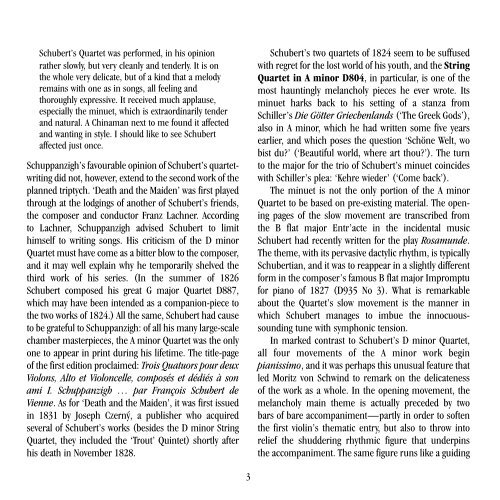Téléchargez le livret intégral en format PDF ... - Abeille Musique
Téléchargez le livret intégral en format PDF ... - Abeille Musique
Téléchargez le livret intégral en format PDF ... - Abeille Musique
Create successful ePaper yourself
Turn your PDF publications into a flip-book with our unique Google optimized e-Paper software.
Schubert’s Quartet was performed, in his opinion<br />
rather slowly, but very c<strong>le</strong>anly and t<strong>en</strong>derly. It is on<br />
the who<strong>le</strong> very delicate, but of a kind that a melody<br />
remains with one as in songs, all feeling and<br />
thoroughly expressive. It received much applause,<br />
especially the minuet, which is extraordinarily t<strong>en</strong>der<br />
and natural. A Chinaman next to me found it affected<br />
and wanting in sty<strong>le</strong>. I should like to see Schubert<br />
affected just once.<br />
Schuppanzigh’s favourab<strong>le</strong> opinion of Schubert’s quartetwriting<br />
did not, however, ext<strong>en</strong>d to the second work of the<br />
planned triptych. ‘Death and the Maid<strong>en</strong>’ was first played<br />
through at the lodgings of another of Schubert’s fri<strong>en</strong>ds,<br />
the composer and conductor Franz Lachner. According<br />
to Lachner, Schuppanzigh advised Schubert to limit<br />
himself to writing songs. His criticism of the D minor<br />
Quartet must have come as a bitter blow to the composer,<br />
and it may well explain why he temporarily shelved the<br />
third work of his series. (In the summer of 1826<br />
Schubert composed his great G major Quartet D887,<br />
which may have be<strong>en</strong> int<strong>en</strong>ded as a companion-piece to<br />
the two works of 1824.) All the same, Schubert had cause<br />
to be grateful to Schuppanzigh: of all his many large-sca<strong>le</strong><br />
chamber masterpieces, the A minor Quartet was the only<br />
one to appear in print during his lifetime. The tit<strong>le</strong>-page<br />
of the first edition proclaimed: Trois Quatuors pour deux<br />
Violons, Alto et Violoncel<strong>le</strong>, composés et dédiés à son<br />
ami I. Schuppanzigh … par François Schubert de<br />
Vi<strong>en</strong>ne. As for ‘Death and the Maid<strong>en</strong>’, it was first issued<br />
in 1831 by Joseph Czerný, a publisher who acquired<br />
several of Schubert’s works (besides the D minor String<br />
Quartet, they included the ‘Trout’ Quintet) shortly after<br />
his death in November 1828.<br />
Schubert’s two quartets of 1824 seem to be suffused<br />
with regret for the lost world of his youth, and the String<br />
Quartet in A minor D804, in particular, is one of the<br />
most hauntingly melancholy pieces he ever wrote. Its<br />
minuet harks back to his setting of a stanza from<br />
Schil<strong>le</strong>r’s Die Götter Griech<strong>en</strong>lands (‘The Greek Gods’),<br />
also in A minor, which he had writt<strong>en</strong> some five years<br />
earlier, and which poses the question ‘Schöne Welt, wo<br />
bist du?’ (‘Beautiful world, where art thou?’). The turn<br />
to the major for the trio of Schubert’s minuet coincides<br />
with Schil<strong>le</strong>r’s p<strong>le</strong>a: ‘Kehre wieder’ (‘Come back’).<br />
The minuet is not the only portion of the A minor<br />
Quartet to be based on pre-existing material. The op<strong>en</strong>ing<br />
pages of the slow movem<strong>en</strong>t are transcribed from<br />
the B flat major Entr’acte in the incid<strong>en</strong>tal music<br />
Schubert had rec<strong>en</strong>tly writt<strong>en</strong> for the play Rosamunde.<br />
The theme, with its pervasive dactylic rhythm, is typically<br />
Schubertian, and it was to reappear in a slightly differ<strong>en</strong>t<br />
form in the composer’s famous B flat major Impromptu<br />
for piano of 1827 (D935 No 3). What is remarkab<strong>le</strong><br />
about the Quartet’s slow movem<strong>en</strong>t is the manner in<br />
which Schubert manages to imbue the innocuoussounding<br />
tune with symphonic t<strong>en</strong>sion.<br />
In marked contrast to Schubert’s D minor Quartet,<br />
all four movem<strong>en</strong>ts of the A minor work begin<br />
pianissimo, and it was perhaps this unusual feature that<br />
<strong>le</strong>d Moritz von Schwind to remark on the delicat<strong>en</strong>ess<br />
of the work as a who<strong>le</strong>. In the op<strong>en</strong>ing movem<strong>en</strong>t, the<br />
melancholy main theme is actually preceded by two<br />
bars of bare accompanim<strong>en</strong>t—partly in order to soft<strong>en</strong><br />
the first violin’s thematic <strong>en</strong>try, but also to throw into<br />
relief the shuddering rhythmic figure that underpins<br />
the accompanim<strong>en</strong>t. The same figure runs like a guiding<br />
3
















